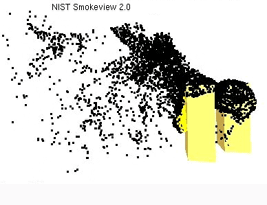

Winter Issue -- 2002
Page 1
Computer Models Recreate WTC
Fires
Page 2
Forest
Fire Detection by Lidar Measurements
Australian
Prison Mattress Fire Tests
Page 3
Tiny
Vibrations Provide Warning of Collapse
Arc
Fault Circuit Interrupters - New Technology in Fire Safety
Page 4
NIST Researcher Recognized for His Work with the Fire Service
Dr. Ronald Rehm and other scientists in the Fire Research Division at the National Institute of Standards and Technology (NIST) are using computer models to help recreate and analyze fire conditions that may have existed in the World Trade Center (WTC) towers before collapse. This work is expected to yield an estimate of the total heat release rates produced by the fires in the towers. In addition, the research is anticipated to provide estimates of local temperatures and heat fluxes to which structural elements remaining after the plane collisions were subjected. Such information will be very important for the structural analyses of the collapses being undertaken now, since elevated temperatures within these elements can lead to significant reduction in the strength of the materials used in these elements.
Photographs
and video footage are some of the most important evidence or
"data" remaining for reconstruction of the events leading to
the collapse of the towers. New data sources are determined almost
daily, and this additional information, about both the exterior damage
and the fire conditions, is used to guide and refine the modeling
efforts.
A major challenge facing researchers is to assign a time-from-ignition to each image. These "time stamps" allow the information from the picture to determine the progression of the fire within each tower for comparison later with the model predictions. Such comparisons then put significant constraints on the modeling and, thereby, improve understanding of the interior damage and fuel distributions within each building.
Until
now, models of the interior damage and of the fuel distributions have
been entirely arbitrary.
There
has been one successful example resulting from the comparison of video
images and the predictions of a mathematical model of the WTC fires. The
video images of the smoke plume down wind of the towers has been
compared with the model predictions of this plume, and a very reasonable
estimate of the total heat release rate (HRR) due to the tower fires has
been made.
If you know of information that may be helpful to the team in unraveling the fire spread and the times of fire events in the buildings please contact Ron Rehm at 301-975-2704 or e-mail ronald.rehm@nist.gov.


SMOKEVIEW generated movie of the predicted smoke plume trajectory from fires in the WTC towers.